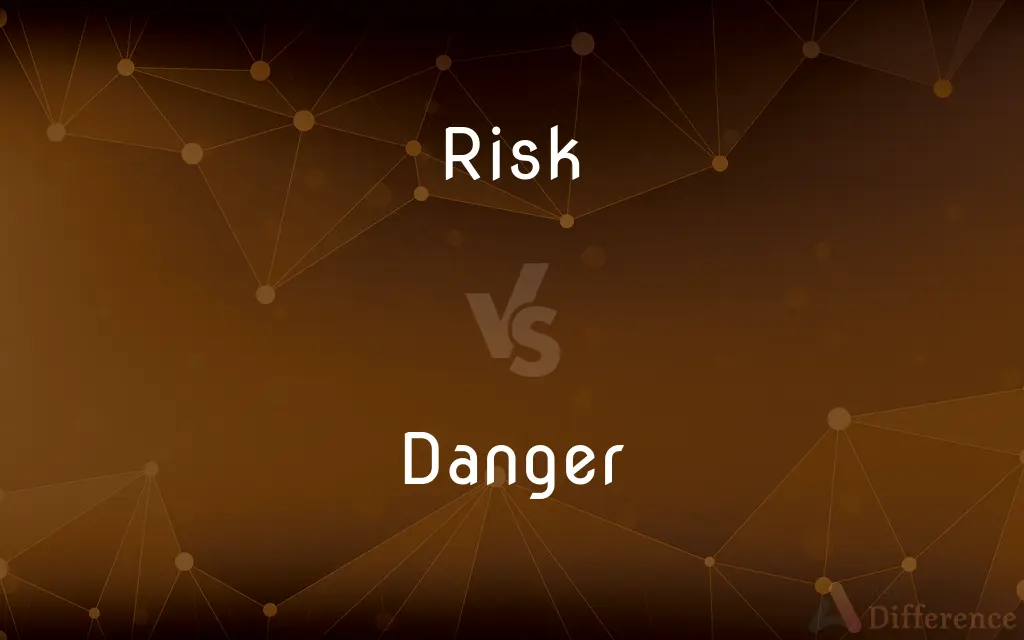Risk vs. Danger — What's the Difference?
By Tayyaba Rehman & Maham Liaqat — Updated on April 15, 2024
Risk involves potential future harm or loss where probabilities are often calculable; danger denotes immediate and clear threats with less predictability.

Difference Between Risk and Danger
Table of Contents
ADVERTISEMENT
Key Differences
Risk refers to the potential of encountering harm or loss, which can often be quantified or assessed using statistics and probability models. In contrast, danger is a more immediate threat to safety or well-being, typically obvious and imminent.
In financial contexts, risk is considered in terms of investment outcomes, calculated through various financial models. Whereas danger is rarely used in this context, focusing more on physical safety in environments like construction sites or during severe weather.
Risks can often be mitigated or managed through careful planning and strategic decision-making. On the other hand, dangers often require immediate action to avoid or minimize harm, such as evacuating a building during a fire.
The perception of risk can vary greatly among individuals, influenced by personal experiences and psychological factors. Conversely, danger is usually more universally recognized and often elicits a swift, collective response.
Risk assessments are crucial in fields like insurance and business to anticipate potential future losses. Whereas danger assessments are critical in safety-critical professions such as firefighting or policing, where immediate threats must be handled.
ADVERTISEMENT
Comparison Chart
Definition
Potential for future harm or loss
Immediate and clear threat to safety
Predictability
Often quantifiable and calculable
Less predictable, often immediate
Contexts
Business, finance, insurance
Safety-critical environments like firefighting
Management
Mitigation through planning
Requires immediate action
Perception Variability
High, varies among individuals
Generally uniform and immediate
Compare with Definitions
Risk
The intentional interaction with uncertainty.
Entrepreneurship is about managing risk effectively.
Danger
A person or thing likely to cause harm or injury.
The convicted criminal was considered a danger to society.
Risk
The possibility that something unpleasant or unwelcome will happen.
Investing in stocks always involves some risk.
Danger
An instance or cause of risk of injury.
Wet floors in supermarkets are a danger to shoppers.
Risk
A quantifiable likelihood of loss or damage.
Actuaries calculate life insurance policies based on risk assessments.
Danger
A threat or likelihood of injury, damage, or loss.
During the storm, residents were warned of the danger from falling trees.
Risk
A situation involving exposure to danger.
Skydiving is considered a high-risk sport.
Danger
The state of being exposed to harm or risk.
The chemical plant was in a state of danger after the explosion.
Risk
The potential for significant returns in business or finance.
High risks are often associated with high rewards.
Danger
The possibility of suffering harm or injury.
The crumbling cliff edge posed a significant danger to tourists.
Risk
In simple terms, risk is the possibility of something bad happening. Risk involves uncertainty about the effects/implications of an activity with respect to something that humans value (such as health, well-being, wealth, property or the environment), often focusing on negative, undesirable consequences.
Danger
The possibility of suffering harm or injury
His life was in danger
Risk
The possibility of suffering harm or loss; danger.
Danger
Exposure or vulnerability to harm or risk.
Risk
A factor, thing, element, or course involving uncertain danger; a hazard
"the usual risks of the desert.
Danger
A source or an instance of risk or peril.
Risk
The danger or probability of loss to an insurer.
Danger
(Obsolete) Power, especially power to harm.
Risk
The amount that an insurance company stands to lose.
Danger
Exposure to likely harm; peril.
There's plenty of danger in the desert.
Risk
The variability of returns from an investment.
Danger
An instance or cause of likely harm.
Risk
The chance of nonpayment of a debt.
Danger
(obsolete) Mischief.
Risk
One considered with respect to the possibility of loss
A poor risk.
Danger
The stop indication of a signal (usually in the phrase "at danger").
The north signal was at danger because of the rockslide.
Risk
To expose to a chance of loss or damage; hazard.
Danger
(obsolete) Ability to harm; someone's dominion or power to harm or penalise. See in one's danger, below.
Risk
To incur the risk of
His action risked a sharp reprisal.
Danger
(obsolete) Liability.
Risk
(uncountable) The probability of a negative outcome to a decision or event.
There is risk of being brutalized, arrested, imprisoned and tortured, all because I want you to know the truth about this matter.
Danger
(obsolete) Difficulty; sparingness; hesitation.
Risk
(uncountable) The magnitude of possible loss consequent to a decision or event.
Danger
(obsolete) To claim liability.
Risk
The potential negative effect of an event, determined by multiplying the likelihood of the event occurring with its magnitude should it occur.
Danger
(obsolete) To imperil; to endanger.
Risk
(countable) A possible adverse event or outcome.
Danger
(obsolete) To run the risk.
Risk
(insurance) A type of adverse event covered under an insurance policy.
Danger
Authority; jurisdiction; control.
In dangerhad he . . . the young girls.
Risk
(countable) A thing (from the perspective of how likely or unlikely it is to cause an adverse effect).
That man is going to be a big risk once he's out of prison.
Those stairs are a major risk.
Danger
Power to harm; subjection or liability to penalty.
You stand within his danger, do you not?
Covetousness of gains hath brought [them] in dangerof this statute.
Risk
A borrower (such as a mortgage-holder or person with a credit card).
A good credit rating indicates the customer is a desirable risk.
Danger
Exposure to injury, loss, pain, or other evil; peril; risk; insecurity.
Risk
(finance) A financial product (typically an investment).
Subprime mortgages are poor risks; especially for a pension scheme.
Danger
Difficulty; sparingness.
Risk
(insurance) An entity insured by an insurer.
Danger
Coyness; disdainful behavior.
Those rich man in whose debt and danger they be not.
Risk
(transitive) To incur risk of (something).
Danger
To endanger.
Risk
(transitive) To incur risk of harming or jeopardizing.
Danger
The condition of being susceptible to harm or injury;
You are in no danger
There was widespread danger of disease
Risk
(transitive) To incur risk as a result of (doing something).
Danger
A venture undertaken without regard to possible loss or injury;
He saw the rewards but not the risks of crime
There was a danger he would do the wrong thing
Risk
Hazard; danger; peril; exposure to loss, injury, or destruction.
The imminent and constant risk of assassination, a risk which has shaken very strong nerves.
Danger
A cause of pain or injury or loss;
He feared the dangers of traveling by air
Risk
Hazard of loss; liabillity to loss in property.
Danger
A dangerous place;
He moved out of danger
Risk
To expose to risk, hazard, or peril; to venture; as, to risk goods on board of a ship; to risk one's person in battle; to risk one's fame by a publication.
Risk
To incur the risk or danger of; as, to risk a battle.
Risk
A source of danger; a possibility of incurring loss or misfortune;
Drinking alcohol is a health hazard
Risk
A venture undertaken without regard to possible loss or injury;
He saw the rewards but not the risks of crime
There was a danger he would do the wrong thing
Risk
The probability of becoming infected given that exposure to an infectious agent has occurred
Risk
The probability of being exposed to an infectious agent
Risk
Expose to a chance of loss or damage;
We risked losing a lot of money in this venture
Why risk your life?
Risk
Take a risk in the hope of a favorable outcome;
When you buy these stocks you are gambling
Common Curiosities
Can risks be managed or reduced?
Yes, risks can often be mitigated through careful planning and strategic decision-making.
What role does perception play in understanding risk and danger?
Perception significantly affects how individuals assess and react to risk, while reactions to danger are usually more immediate and uniform.
Are dangers always visible or obvious?
Dangers are typically more immediate and recognizable compared to risks.
How do businesses typically handle risks?
Businesses handle risks through assessments, insurance, and strategic planning.
What kind of training is involved for professions dealing with high danger?
Professions dealing with high danger, like firefighting or police work, require rigorous physical training, tactical training, and continuous education on safety protocols and emergency response.
Why is understanding danger important in safety-critical jobs?
Understanding danger is crucial in safety-critical jobs to prevent accidents, save lives, and maintain overall safety in high-risk environments.
What is the role of risk in decision-making?
Risk plays a central role in decision-making by helping individuals and organizations evaluate potential negative outcomes and decide whether the potential rewards outweigh the risks.
What is the main difference between risk and danger?
Risk is about potential future harm that can often be calculated, while danger refers to immediate and obvious threats.
How is risk quantified in business settings?
In business, risk is quantified using probability models, statistical analysis, and historical data to predict potential losses and gains.
Can danger be predictable in any way?
While danger is less predictable than risk, it can sometimes be anticipated in scenarios where the conditions leading to danger are known, such as in natural disaster-prone areas.
What tools are used to manage risks?
Tools such as risk assessments, insurance, safety protocols, and contingency planning are commonly used to manage and mitigate risks.
What measures can individuals take to reduce exposure to danger?
Individuals can reduce exposure to danger by following safety guidelines, using appropriate safety gear, avoiding known hazardous situations, and staying informed about potential threats in their environment.
Is there a psychological aspect to how people perceive danger?
Yes, psychological factors like past experiences, fear, and personal thresholds for uncertainty significantly influence how individuals perceive danger.
How do companies prepare for unforeseen dangers?
Companies prepare for unforeseen dangers through emergency response plans, safety drills, employee training, and by maintaining essential safety equipment.
How does insurance relate to the concepts of risk and danger?
Insurance primarily deals with risk by providing financial protection against potential future losses, while it indirectly addresses danger by covering costs associated with immediate threats.
Share Your Discovery

Previous Comparison
Westernization vs. Modernization
Next Comparison
Distributor vs. FranchiseAuthor Spotlight
Written by
Tayyaba RehmanTayyaba Rehman is a distinguished writer, currently serving as a primary contributor to askdifference.com. As a researcher in semantics and etymology, Tayyaba's passion for the complexity of languages and their distinctions has found a perfect home on the platform. Tayyaba delves into the intricacies of language, distinguishing between commonly confused words and phrases, thereby providing clarity for readers worldwide.
Co-written by
Maham Liaqat















































